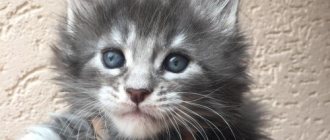Causes
The most common causes of sore throat in cats are calcivirus, herpes, chlamydia, mycoplasma and rhinovirus infections.
However, viruses rarely affect a healthy animal or the absence of provoking factors. These include:
- Eating cold, poorly defrosted food or water.
- Injuries, especially from chicken or fish bones.
- Decreased immunity.
- Diseases of the teeth or gums.
- Inhalation of toxic fumes or gases.
Sometimes the main viral sore throat can be complicated by the addition of a secondary infection.
The causes of swallowing disorders are usually divided into several large groups:
- mechanical;
- traumatic;
- caused by infectious brain damage;
- caused by damage to the cranial nerves.
Oral distress can be caused by trauma to the jaw, dental disease, or abscesses in the mouth or throat. In this case, swallowing is impaired due to acute pain. If an animal is injured, there may be visible violations of the integrity of the bones, blood in the saliva, bad breath, and an abscess leads to deformation of the jaw at the site of formation.
Lymphadenopathy (inflammation of the lymph nodes of a bacterial nature or the formation of tumors) in the submandibular region leads to visible deformation of the neck, difficulty swallowing, the animal may be apathetic, its temperature rises and all other signs of general intoxication appear.
Congenital anomalies (cleft palate or short frenulum of the tongue) make it difficult for the animal to eat without losing its appetite. With a cleft palate, some of the food gets into the nose, the animal may sneeze and cough, and choke.
Swelling of the pharynx due to allergies or inflammation leads to a narrowing of the pharyngeal ring and difficulty in moving food. Allergies can cause laryngospasm and suffocation.
Ordinary myositis, inflammation of the masticatory muscles, can lead to impaired swallowing. Due to pain and dysfunction, it is difficult for the animal to chew food. Dysphagia can be caused by infectious polymyositis caused by toxoplasmosis.
Damage to the nerves (trigeminal, glossopharyngeal, cranial) leads to the inability of the animal to move food using the tongue; it tries to solve the problem using adaptive behavior.
Swallowing disorders can develop after a stroke, traumatic brain injury, and some other pathologies affecting the animal’s brain. In this case, the cat experiences not only a loss of the ability to swallow, but also other disorders, paralysis, and loss of consciousness.
Autoimmune diseases, polyneuropathy, muscular dystrophy that affects the masticatory apparatus lead to the fact that the animal cannot perform the usual chewing and swallowing movements.
Some infectious diseases lead to muscle damage or disruption of the transmission of nerve impulses to the masticatory muscles, for example, botulism, rabies, tick-borne encephalitis. All these diseases are accompanied by their characteristic symptoms.
A foreign body is one of the most common causes of swallowing disorders in animals. Particularly often affected are cats whose owners feed them fish or allow them to gnaw on the tubular bones of birds. In this case, the bone can get stuck in the soft tissues of the palate or pharynx, the animal coughs, vomits, and tries to scratch with its paws near the cheeks and mouth.
Diagnostics
The first step is to determine whether there is a viral or bacterial infection. A routine blood test will help you do this. If there is an increased number of white blood cells, bacteria may be present.
It is also necessary to conduct a serological blood test for calcivirus or herpes infection. Bacterial analysis is carried out by inoculating material from scrapings from the tonsils.
In cats, it is difficult to examine the pharyngeal cavity, so laryngoscopy is used for this - a special tube with a video beacon, which is inserted into the mouth.
It is also necessary to do a culture of the nasal discharge and mouth to detect chlamydial infection.
To exclude collapse of the trachea or the presence of a foreign body, an x-ray is performed to diagnose the neck area.
Prevention
- Do not give your cat poorly thawed or refrigerated food, as well as cold water.
- Do not store cat food in the refrigerator.
- Keep small and sharp objects out of reach of your cat, especially sewing needles.
- Do not give your pet chicken and fish bones.
- Strengthen your immune system.
- Get vaccinated against dangerous viral infections on time.
- When purchasing a kitten, ask the breeder about the availability of vaccinations and illnesses of the parents, including during pregnancy.
We suggest you read: How to calm a cat at home if she starts walking
Sore throat, also known as acute tonsillitis - inflammation of the swallowing ring, accompanied by swelling of the throat and tonsils, caused by microorganisms, most often staphylococci and streptococci.
Sore throat in cats is an inflammation of the throat, larynx, and tonsils, accompanied by pain, nasal discharge, and swelling of the mucous membranes.
When to see a doctor?
It is necessary to visit a doctor at the first sign of a sore throat and sore throat, but not all patients adhere to such recommendations. To prevent serious consequences, be sure to visit a doctor if:
- after five days of home treatment, the throat does not go away;
- pain becomes more and more intense;
- a rash appeared on the skin;
- severe hoarseness persists, voice has disappeared;
- It's hard for you to breathe!
- severe inflammation of the lymph node has occurred, you can check by feeling with your fingers;
- there are complaints of dehydration and weakness throughout the body.
We invite you to familiarize yourself with Launching a new aquarium (for beginner aquarists)
Types and signs of sore throat in animals
Diagnosing diseases in humans and animals are at very different levels, so the question of the relevance of the topic of sore throat in cats in general often arises. If you are wondering whether cats have tonsillitis, the answer is that it happens, however, this concept has a broader meaning than you are used to thinking.
According to the nature of the development of the disease, there are two types of sore throats:
- Chronic or sluggish, can last for months.
- Acute – dissipates quickly, most often accompanied by an increase in temperature, leukocyte levels and ESR in the blood. The acute form of tonsillitis is more difficult to tolerate, but with proper treatment, it quickly stops.
The cause of the disease can be several types of microorganisms; accordingly, tonsillitis can develop according to different “patterns”. Based on the nature of the inflammation, the following types of sore throat are distinguished in cats:
- Catarrhal – accompanied by soreness, slight discomfort, and pain when swallowing. The pharynx is inflamed, the tonsils are slightly enlarged, the tongue is covered with a light coating, the temperature is stable and increased by 1–2°C, there is no fever, the pulse and breathing are rapid.
- Croupous - accompanied by swelling and narrowing of the swallowing ring, the temperature is increased by 2–3°. In the acute form, there are symptoms of breathing problems, shortness of breath, refusal to eat and drink, a sore throat, pale mucous membranes. Attempts to eat are accompanied by coughing and the discharge of foamy discharge with food particles from the nose.
- Diphtheria is a rare form, accompanied by the appearance of a characteristic grayish-white coating, high fever, damage to all mucous membranes of the mouth and nose, and sometimes bleeding. The danger of diphtheritic sore throat is its rapid progression and a wide range of, sometimes irreversible, complications. The type is divided into two subtypes: Localized - the process occurs with general signs of malaise and is complicated by anemia, loss of strength, dizziness, and loss of appetite.
- Toxic - a rare, acute form of the disease, accompanied by fever, swelling of the respiratory tract, swollen lymph nodes, and increased salivation.
- Ulcerative – on the visible surface of the pharynx, most often small ulcers open in the area of the tonsils. It seems to the animal that a foreign object is stuck in the throat; the cat opens its mouth, sticks out its tongue, and coughs. The disease can occur without an increase in base body temperature.
- Diphtheria is a rare form, accompanied by the appearance of a characteristic grayish-white coating, high fever, damage to all mucous membranes of the mouth and nose, and sometimes bleeding. The danger of diphtheritic sore throat is its rapid progression and a wide range of, sometimes irreversible, complications. The type is divided into two subtypes: Localized - the process occurs with general signs of malaise and is complicated by anemia, loss of strength, dizziness, and loss of appetite.
- Toxic - a rare, acute form of the disease, accompanied by fever, swelling of the respiratory tract, swollen lymph nodes, and increased salivation.
Treatment of sore throat in cats at home
Self-treatment comes down to comprehensive support of the body and increasing the level of immunity:
- Set up a comfortable resting place in a warm, well-ventilated area without drafts.
- The drinking bowl, feeder, litter tray and all pet accessories are transferred to the “hospital”.
- Avoid active games, pick up your pet more often, talk to the animal, and encourage it.
- Increase your caloric intake by 10–15%, avoiding fatty, hard, hard-to-digest foods.
- Provide the animal with warm liquid food.
If negative trends are observed on day 2, consult a veterinarian by phone. Based on your medical history, the doctor will tell you how to treat and possible options for maintaining the body, most often these are:
- Subcutaneous or intravenous glucose infusions.
- Warming alcohol compresses.
- For severe bacterial forms - penicillin, streptomycin, sulfadimezin, norsulfazole with parallel support of intestinal microflora.
One of the most common throat diseases in cats is sore throat or acute tonsillitis. Often, simple inflammation can develop into viral stomatitis. Therefore, it is necessary to closely monitor the animal in order to notice at the first signs when the cat has a sore throat, and to avoid complications with the help of timely treatment.
We suggest you familiarize yourself with: DIY cat harness
Symptoms and treatment of throat diseases in cats
Additional information:Diseases of cats
Diseases affecting the oral cavity (mouth) and pharynx (pharynx) in cats are not uncommon. Such diseases are called oropharyngeal.
The range of such diseases is quite wide, some of them are easily diagnosed and treated, while others are difficult to identify and treat. Some diseases are difficult to treat because the causes that cause them are not fully understood.
There are many signs that indicate that your cat has problems with the oral cavity or pharynx, including:
- Loss of appetite. The cat stops being interested in food, or goes to the saucer, but refuses to eat;
- Dysphagia. Swallowing disorder indicates difficulty eating or swallowing food—the cat eats with apparent caution, shows signs of discomfort, may drop food from its mouth, or has difficulty swallowing;
- Ptyalism is excessive salivation or drooling from the mouth (sometimes with bleeding);
- Halitosis is an unpleasant odor from a cat’s mouth;
- The cat scratches or rubs its mouth with its paws, sometimes shaking its head;
- Weight loss - usually due to lack of appetite;
Symptoms
In veterinary practice, we most often observe those that develop most suddenly (in the case of an allergic reaction). The animal suddenly becomes ill, the cat breathes heavily and wheezes, and screams in a voice that is not its own. In milder cases, the cat “simply” cannot drink or eat, and wheezes or “grunts” hoarsely and with whistling sounds.
It should be noted that owners of Persian cats and animals of similar breeds, even in this case, rarely begin to sound the alarm and you should not blame them for “callousness”. The fact is that these representatives of the cat tribe initially have difficulty breathing due to the special structure of the nasal cavities.
Anaphylactic shock is especially insidious. Roughly speaking, this is a type of allergic reaction. At the same time, the larynx swells so quickly and so much that the owners do not always have time to take the cat to the veterinary clinic... Thus, if your pet suddenly begins to wheeze, sniffle, behave inappropriately and suffocate, immediately go to the veterinarian.
How to treat a cat's throat?
Veterinarian Georgy Kolev answers questions from KP readers
Our cat has a very sore throat. We were advised to treat it with Lugol and soda solution. I’ve been following all the doctor’s recommendations for several days now, but I don’t see any improvement. How to help our pet? Julia. — Julia, it is very correct that you closely monitor the health of your pet. After all, simple inflammation can often turn into viral stomatitis. And this is a serious disease that can cause many problems for your pet.
It is very difficult to gargle with a soda solution for a cat, since it is very difficult to explain to the animal that you want to help him. Moreover, it is not very effective. Personally, I advise switching to antibiotics and immunostimulating drugs. Moreover, it is better to give preference to injections. You can learn how to give injections yourself.
It would be nice if you have an assistant. It’s better, of course, to watch how a veterinarian gives injections for the first time.
Veterinarian Georgy Kolev answers questions from KP readers
Predisposing factors
- Severe hypothermia. Don’t send your pet “for a walk” when it’s bitterly cold outside! In general, this is a good prevention of many diseases.
- Low-quality feed containing mold or mold toxins. Such “yummy” food can also cause liver cancer, to say nothing of inflammation of the larynx!
- Eating river fish, abundantly stuffed with bones. If one of them sticks into the throat, then it will be much easier for the conditionally pathogenic microflora to “reclassify” as pathogenic!
Lip diseases in cats.
Eosinophilic ulcers.
Separately, there are diseases of the lips such as eosinophilic ulcers (corroding ulcers, ulcers on the lips). These diseases are a type of skin disease that appears on the lips as ulcers along the edges of the upper lip, often radiating toward the midline.
Corroding ulcers in a cat with allergic skin disorders. Photo: M van de Stadt-Gould
Over time, the ulcers may enlarge and bleed. The edges of the ulcers become swollen, and the ulcer itself is usually pink in color. The cat may not show other signs, but deep ulcers can cause severe pain, cause loss of appetite, and the cat may stop grooming its coat.
The underlying cause of eosinophilic ulcers is usually unknown, but may include (or be aggravated by) bacterial infections, allergies, and trauma caused to the skin by the cat's own rough tongue.
The disease, as a rule, has a rather characteristic external manifestation, but to distinguish it from more serious diseases (such as neoplasm), a biopsy and histological studies are recommended. Various methods are used for treatment, but there is no universal method that gives a successful result.
This is due to the difference in the nature of the factors that led to the formation of ulcers. In some cases, the cat's condition will improve with antibiotics, but treatment with corticosteroids such as predinosolone is usually more successful. If ulcers are of an allergic nature, identifying the allergen that leads to the disease is very useful.
Malignant neoplasia (cancer) of skin cells can affect the lips and skin around the nose, as well as the mucous membrane lining the mouth and tongue.
We invite you to familiarize yourself with: Circleless pigeons distinctive features
Excessive drooling.
Excessive drooling (hypersalivation, ptyalism or sialosis) can develop for two main reasons - if too much saliva is produced (a condition called ptyalism or sialosis) or if the cat is unable to effectively swallow the resulting saliva. In any case, there is drooling.
A more serious cause of drooling is rabies, so this is the option veterinarians check first. Treatment requires identifying the underlying cause. If the skin is not kept as dry as possible, irritation of the lips and face may begin in a short time. In such cases, the veterinarian recommends cleaning with suitable antiseptic agents.
What to do if your cat has a sore throat?
In the case of the lips, this can cause the formation of ulcers, which must be distinguished from eosinophilic ones (using a biopsy).
Treatment options for squamous cell carcinoma in cats include local radiation therapy (brachytherapy), surgical excision, and cryosurgery (freezing affected tissue to cryogenic temperatures). The success of treatment depends on the degree of development of carcinoma. With timely diagnosis, it is often possible to completely remove cancerous tumors.
A cleft lip is a congenital defect in which a cat's upper lip is not fully formed. A cleft lip is noticeable in kittens immediately after birth. The defect may extend to the nose and be accompanied by a cleft palate (a defect in the upper part of the mouth). The severity of the disease can vary and to a moderate extent may not interfere with the cat's normal life.
Malignant tumors.
Squamous cell carcinoma is the most common malignant tumor in the oral cavity of cats. Usually occurs on the gums and tongue, then quickly spreads throughout the mouth.
Symptoms depend on the location and size of the tumor. Typically, symptoms include bad breath, refusal to eat, and excessive drooling. If the swelling affects the back of the mouth or throat, swallowing may be difficult. The tumor often has ulcers and bleeds. Your cat's face may become swollen as the tumor enlarges and invades surrounding tissue.
Treatment and prognosis depend on the type of tumor and its stage. Malignant melanomas are highly invasive and grow rapidly, so the prognosis is poor. Surgical removal improves the chances of survival and may even eliminate the tumor, but recurrences are common. Squamous cell carcinoma has a poor prognosis and survival is only possible with early diagnosis and treatment. Removing a tumor often requires removal of the lower jaw.
Oral diseases in cats.
Acute stomatitis.
Acute stomatitis is a rapidly developing inflammation of the oral mucosa. Often accompanied by inflammation of the tongue (glossitis) and/or inflammation of the throat (pharyngitis).
The most common causes of stomatitis are:
- Calicivirus or herpesvirus infection (cat flu). Both feline calicivirus (FCV) and feline herpes virus (FHV) can cause inflammation in the mouth, usually accompanied by other upper respiratory symptoms such as sneezing and nasal and eye discharge. Calicivirus infection usually causes sores in the mouth, often on the edges of the tongue, but sometimes in other places, including the cat's nose. Herpesvirus often causes more severe consequences than calicivirus, and signs of infection in some cats include quite noticeable pharyngitis, but ulcers are less common.
- Irritations. Many common household substances - cleaning products, paint, bleaches, etc. may be irritating to cats. Out of curiosity, the cat may sometimes lick or swallow them, causing irritation in the mouth and throat. In some cases, the consequences can be very severe. The best protection is to prevent your cat from coming into contact with such substances, so they should be stored in a safe place, out of reach of the cat.
- Dental diseases, gingivitis.
Dental disease, periodontal disease (the tissue around the tooth), and gingivitis are also common in cats, as in other animals.
Several types of tumors are possible in cats. To make an accurate diagnosis, a biopsy of tumor tissue is necessary. Malignant tumors (cancer) are more common than benign tumors, with squamous cell carcinoma (a cancerous growth of epithelial cells in the lining of the mouth) appearing to be the most common type of tumor.
Oral tumors rarely spread to other parts of the cat's body, but often recur after removal. An exception to the rule is squamous cell carcinoma of the tonsils, which often spreads to other tissues. In all cases, the effect of treating cancerous tumors is temporary, and you need to be prepared for the fact that sooner or later you will have to resort to euthanasia in order to avoid unnecessary suffering.
Diseases of the salivary gland are rare in cats. In very rare cases, blocked salivary ducts can cause swelling under the tongue or in the neck. This condition can be successfully treated surgically. It is extremely rare for cats to develop tumors of the salivary glands.
Foreign bodies.
It is not uncommon for foreign bodies, such as wood chips or bones, to become wedged into the palate or between the cat's teeth. This causes extremely unpleasant, often painful sensations in the cat. The cat rubs its mouth with its paws, trying to get rid of a stuck foreign object. To remove a foreign body, local and sometimes even short-term general anesthesia is used.











